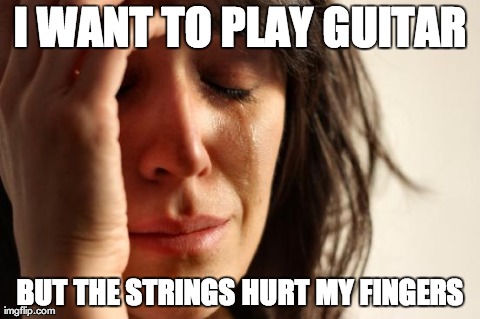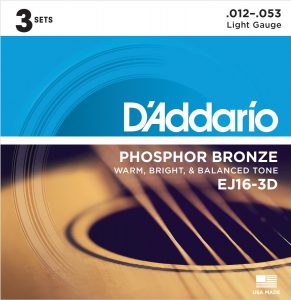This post may contain affiliate links. Please read my disclosure for more info.
So you’re having trouble learning the guitar. You want to learn guitar, but you can’t quite get the hang of it.

That’s ok. Don’t feel bad. Stop being a baby. Step up and take control…and own that guitar.
But seriously, here’s what you should do if your fingers hurt and you’re struggling to play the guitar…
First, are you a beginner?
If not – you should check out this article about practicing. You should check out that article even if you are a beginner, since it applies to everything from guitar to piano to chess to football. But really, the tips included below are geared towards total guitar newbies or beginners.
Ok – are all of the experienced players gone now?
Good.
So you have sore fingertips (Specifically, finger issues with the hand you use to fret notes: e.g. left hand if you are a right-handed guitar player)
That’s normal. And probably good. Well… specifically it’s normal for the skin on your fingertips to be a little sore. Your fingers need to develop calluses – these are basically toughened areas of skin on your fingertips. The more you play (i.e. the more your delicate fingertips rub up and down on the strings of your guitar), the sooner and tougher your fingertips will get… and ultimately the sooner they will stop being sore. This could take a week or a month depending on how often you play.
The types of strings (and guitar) you use will also make a difference.
Nylon strings on classical guitars vs metal strings on electric guitars will do different things to your hand (these guitars also require variations in technique, which can have different impacts on your fingers). I’m not saying one is better or worse – but just keep it in mind.
How old are your strings?
Really old and dirty strings will do different things to your fingers when compared with slick, new clean strings. If you’re having fingertip soreness, maybe you should try some new strings. And maybe those new strings should be a lighter gauge. And maybe those new strings should be these light gauge acoustic Elixir strings.
D’addario also makes a similar string.

These strings basically have a coating that is supposedly more mellow sounding and easier on your fingers. I’ve heard that the coating on the Elixir strings peels after awhile, but whatever – I like them either way.
UPDATE: We got a great recommendation in the comments from reader John (thanks John!). He suggests going in the opposite direction and putting heavier gauge strings for awhile. This is a great idea.
Toughening up your fingers with a heavier gauge will feel brutal at first – but when you switch back to a lighter gauge it will feel amazing.
You should also try a bunch of different types of strings.
I give my recommendations (Elixir and D’Addario), but it’s easy to find some of the best guitar strings – go try some out.
Check out that action (i.e. the distance of the strings from the neck of the guitar).
Ok – when you press down on a string to play a note – do you have to press really hard to get the note to make the right sound? Is the gap between the string and the fretboard really close (like so close you can’t even see how close) or really far (in this case, far could be only 1/8″ or 1/4″).
All of this is to say: The reason your fingers may be sore, is that the distance of the strings from the fretboard is far, which means you have to press really hard, which means your tender little digits are getting sore. This fix is a little trickier than changing strings… just bring it to a guitar shop/store and have someone check it out (it could cost $30 – $75 to “set up” your guitar).
I should note though: Even though having a lower action can make playing guitar a lot easier, don’t forget the benefit of having a high action (as a practice method). In the same way that using a heavier gauge string can help toughen your fingers, having higher action can do the same. Your fingers will get strong and tough – and when you switch to a lower action – it will be so much easier to play.
One other quick tip – sometimes using a capo on the 2nd or 3rd fret can lower the action a bit and make it easier on your fingers… sometimes.
That’s it for now.
Any additional thoughts, comments, issues? Did I miss something? Do you disagree… leave a nasty comment below and tell me what’s up!
17 replies on “I’m Having Trouble Learning the Guitar… (THE STRINGS HURT MY FINGERS!!!)”
im a beginner player and im trying to develop my finger tips better but is there a way so it doesnt hurt so bad
Hey Allison! First off: YOU CAN DO THIS! I’ve seen little kids handle it – as well as older adults. You got this! Here is what I suggest: Play a lot, but only for a little bit at a time.
Practice every day (seriously every day), but only practice for a few minutes.
If you want to get your fingers to get tougher, practice a few times EVERY day, but again: only for a few minutes (like less than 5).
Here’s why: Your fingers need to adapt to the new activity. They need to get used to feeling those strings. The only way they’ll get used to them is to practice/play the guitar. It’s simple – but not easy.
The good news: Your fingers need to take breaks. Just like with exercise, you need rest to get better. Same thing with your fingers. They need breaks, otherwise the pain will be too much to handle and they’ll never get stronger/tougher/calloused.
The bad news: You gotta do it every day. If you take too much time off (or have too much of a break) your fingers will never get tough and you’ll constantly have finger pain.
So play a lot, but for short amounts of time. After a few weeks, you’ll feel good.
Two other things:
1. Make sure you’re using the TIPS of your fingers (NOT the part where your fingerprints are)
2. There is always going to be SOME discomfort. It should hurt constantly, but a little discomfort is normal. Get used to that.
That’s it! Good luck! And keep me posted with your progress!
Hi. I wrote this on your other post. I wasn’t trying to be a smart-ass. I hurt a lot, and I have been…anyways, I’m old. I put a set of 13 gauge on there once in a while, then switch to lower gauge. It really helps me. It might help others. Cool page BTW. Peace.
P.S. I know you have mentioned the string gauges, but alternating also helps.
Awesome… thanks John. I’ve added your suggestion to the article. Thanks for sharing!